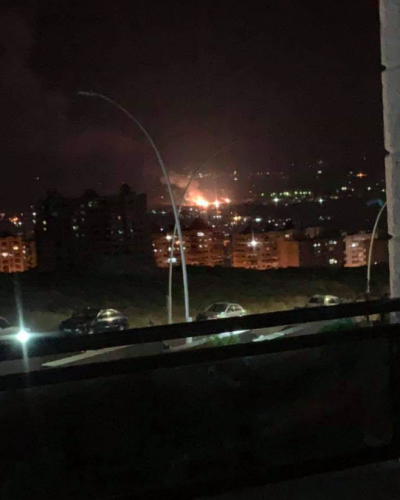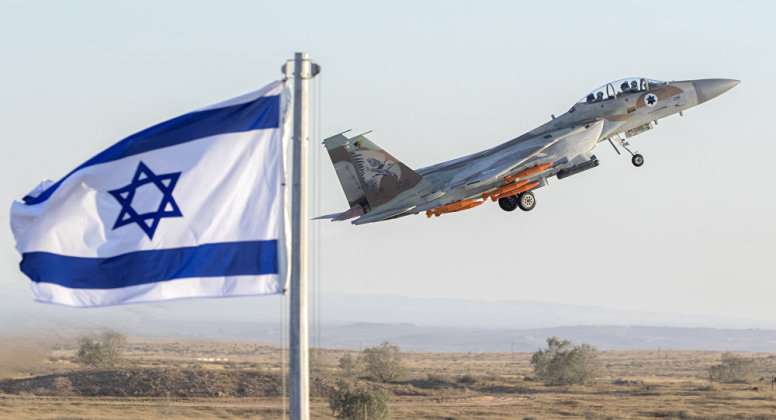
The ‘Jewish’ Israel bombed several posts in central and coastal Syria in the early hours of the morning today, Saturday, November 19, a Syrian military spokesperson said in a statement carried by the Syrian news agency SANA.
In its report, strangely not the website’s main headline, SANA quoted the Syrian military spokesperson:
“At about six thirty in the morning, the Israeli enemy carried out an air aggression from over the Mediterranean Sea from the direction of Baniyas, targeting some points in the central and coastal region, and our air defenses intercepted the incoming missiles of aggression and shot down most of them.”
The Israeli aggression killed four soldiers and injured one more in addition to causing material damage, the military spokesperson’s statement concluded.
This is the second Israeli aggression against Syria in the past 6 days, the previous aggression killed and injured Syrian army soldiers.
The Israeli (Read: NATO and the collective West through Israel) aggressions are blatant violations of International Law, the UN Charter, and the May 31st, 1974 ‘Separation of Forces Agreement between Israel and Syria,’ dozens of useless UN peacekeepers (UNDOF) were deployed since on the Golan to observe the agreement whose role is just to count the Israeli aggressions and report it to the UNSC which in turn calls for peace in useless statements.
The role of Russia remains very strange in the continuous Israeli aggressions, the Russian military has an agreement with Israel on non-confliction over Syria’s skies, and holds back weapons Syria purchased over a decade ago under request from the Israelis despite the fact that some of those dated weapons like the S300 are very much available in NATO countries including NATO’s launchpad post against Russia, Ukraine.
Moreover, Russia offered its more advanced S400 to countries hostile to it like Saudi Arabia and Qatar, and actually sold it to other countries in its opponent camp like Turkey, all of which are parts of the US-led war of terror and attrition against the Syrian people.
The least that Russia can do in light of the repeated Israeli aggressions is not some empty words of condemnation by its foreign ministry, but rather withdraw itself from the weird agreement of coordination with Israel over Syria, which itself is against international law that Russia is saying it wants to preserve, draw down its diplomatic ties with the ‘Jewish’ state, or pressure the Israelis with fewer revenues through trade and tourism if the Israelis continue their breach of the UN Security Council resolutions which Russia is one of 5 permanent members of.
The same, above, goes for China, another permanent member of the UNSC that has very large economic and military ties with Israel.
That is if Russia does not want to sell its advanced weapons to Syria and actually allow the Syrian people to defend themselves with the weapons it delivered earlier.
The ‘Jewish’ state of Israel that commits crimes against the real Semites, the people of the Levant around the clock including on Sabbaths, needs wars to continue its illegal occupation of land, peace will force its criminal leaders to look after the Jews expelled from Europe and from Russia and shipped into Palestine to serve the overall Zionist dream of building the antiChrist’s kingdom.

Will Syria be able to restrain itself before retaliating militarily against Israel and its regional sponsors and causing mutual destruction to all parties, not only to Syria alone, is no longer a question, it’s a matter of when the retaliation strikes will start, Syria has nothing further to lose, unlike all its foes who contributed to its destruction.
Syria News is a collaborative effort by two authors only, we end up most of the months paying from our pockets to maintain the site’s presence online, if you like our work and want us to remain online you can help by chipping in a couple of Euros/ Dollars or any other currency so we can meet our site’s costs.
You can also donate with Cryptocurrencies through our donate page.
Thank you in advance.
Filed under: "Israel", House of Saud, Qatar, Russia, Syria, Syria Golan Heights, UN Security Council (UNSC), UNDOF, US-led NATO Alliance, Vladimir Putin | Tagged: Global war on Syria, KSA, Palestinian Holocaust, S-300 Sale to Syria, S-400, Syrian Arab Army SAA | Comments Off on Israel Bombs Syria Killing 4 Soldiers, its 2nd Aggression in 6 Days
























